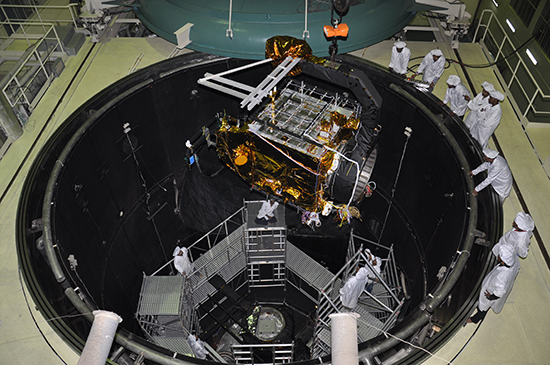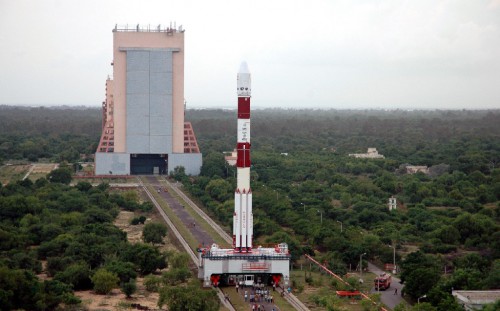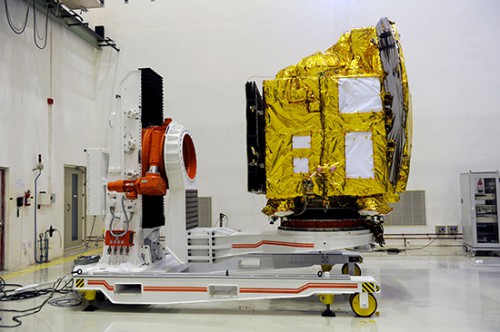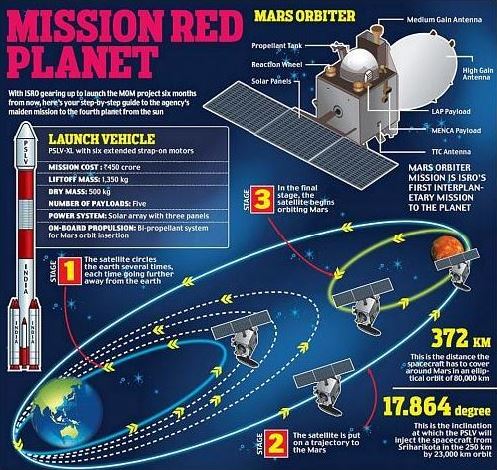
Only days remain before the opening of the next “launch window” to the Red Planet, with NASA’s Mars Atmosphere and Volatile Evolution (MAVEN) mission scheduled to fly atop an Atlas V from Cape Canaveral Air Force Station, Fla., on 18 November and India’s long-awaited Mars Orbiter Mission (MOM)—also known as “Mangalyaan” (Hindi for “Mars Craft”)—from the Satish Dhawan Space Centre, on the barrier island of Sriharikota, in India’s southern state of Andhra Pradesh, on 28 October. Integration of the four-stage Polar Satellite Launch Vehicle (PSLV) for India’s first mission to Mars is now complete and, according to an article in The Hindu newspaper, the Launch Authorisation Board will meet today (Thursday) to approve the installation of MOM/Mangalyaan atop the rocket.
“The spacecraft will be put on the launcher on 18 October,” the newspaper explained, “and another round of readiness checks will be done on the combined entity. After that, the Launch Authorisation Board will monitor the weather conditions and authorize the countdown and the process will begin.” The recent ravages of Cyclone Phailin have affected much of India, including the Andhra Pradesh region, together with vast swathes of Thailand, Myanmar, and Nepal. First identified as a tropical depression to the west of Cambodia on 4 October, Phailin quickly moved westwards and entered the Bay of Bengal early last week. By 10 October, it was reclassified as a Very Severe Cyclonic Storm and its ferocity steadily intensified to the equivalent of a Category 5 hurricane. In Andhra Pradesh, some 64,000 people were evacuated from low-lying areas, but the coastal regions escaped much of Phailin’s wrath. Although it began to weaken on Sunday, 13 October, meteorologists from the Indian Space Research Organisation (ISRO) are paying keen attention to the weather in the Bay of Bengal and the South Pacific Ocean over the coming days.
“ISRO’s weather assessment gives it a 10-day “clear time” within the overall period of 28 October-19 November,” The Hindu noted. “By then, the orbiter must be put in space.” Quoting IRSO’s Chairman, Dr. K. Radhakrishnan, the newspaper highlighted the presence of moving weather systems in the South Pacific and, since Fiji will provide critical tracking support in the early stages of the mission, continuous monitoring is urgently needed. “These are part of our operational challenges,” explained Dr. Radhakrishnan. Mission preparations at the Bangalore-based ISRO Telemetry, Tracking and Command Network (ISTRAC) and Indian Deep Space Network (IDSN) were reviewed on Tuesday, 15 October. Pending a satisfactory conclusion to its deliberations, the Launch Authorisation Board is expected to formally fix the target launch date for MOM/Mangalyaan on Friday.

According to the Fiji Times—and reported by NASASpaceflight.com—two shiploads of ISRO telemetry equipment and 18 personnel are in the process of arriving in Fiji to track the ignition of the PSLV’s fourth stage and monitor the injection of MOM/Mangalyaan into space. “Scientists expect the rocket to enter space from somewhere high above Fiji’s airspace,” the Fiji Times noted yesterday (Wednesday). India’s High Commissioner to Fiji, Vinod Kumar, expressed thanks to the Fijian government for their support of the mission, praising its “ideal location, being a communication hub, and our close and friendly relations.” As part of the goodwill gestures, India presented a model of the PSLV rocket and the MOM/Mangalyaan spacecraft to Fijian President Epeli Nailatikau.
As detailed in a recent AmericaSpace article, the current partial shutdown of the U.S. government will not prevent NASA from providing communications and tracking support for the mission, through the large antennas of its Deep Space Network (DSN), based in California, Spain, and Australia. The NASA coverage will be necessary at times when MOM/Mangalyaan is not visible to the Indian Deep Space Network, whose 105-feet (32-meter) and 60-feet (18-meter) antennas near Bangalore will provide primary navigation and tracking services.
This is a highly ambitious—and almost unlikely—mission for the world’s second most populous nation, having only received formal approval and a $41 million financial allocation from the Indian government in August 2012. With estimated costs as high as $100 million, the mission unsurprisingly drew criticism last year from those who pointed to India’s power failures and the risk of drought in the aftermath of weak monsoon rains. Quoted by the BBC, one Indian government official bit back at the critics. “If we don’t dare dream big, it would leave us as hewers of wood and drawers of water,” the official declared. “India is today too big to be just living on the fringes of high technology.”

Described as “a technology demonstration project,” MOM/Mangalyaan’s primary task is to prove that India has the technical capability to design, plan, manage, launch, and operate a deep-space mission across the vast gulf to reach the Red Planet. The spacecraft carries a payload of five scientific instruments—the Methane Sensor for Mars (MSM), Mars Colour Camera (MCC), Mars Exospheric Neutral Composition Analyzer (MENCA), Thermal Infrared Spectrometer (TIR), and Lyman-Alpha Photometer (LAP)—and will be dedicated to developing a clearer understanding the morphology, topography, and mineralogy of the Martian surface, the dynamics of its tenuous upper atmosphere, the effects of the solar wind and radiation, and the nature of the planet’s large moon, Phobos.
Liftoff of the mission was scheduled within a month-long Mars “launch window,” which extends from 21 October until 19 November, and after a national committee of experts—including professors from the Indian Institute of Science at Bangalore and the famed Indian aerospace scientist and fluid dynamicist Roddam Narasimha—gave the formal go-ahead, it was announced on 22 September that the flight would begin, weather permitting, on “the first available opportunity” on 28 October. According to Spaceflight Now, the launch window opens at 4:15 p.m. local time (6:45 a.m. EDT). Assembly of the PSLV rocket at the Sriharikota launch site began in early August and is now complete and awaiting tomorrow’s planned integration of the MOM/Mangalyaan payload.
Developed and operated by ISRO, the PSLV is one of the most reliable members of India’s fleet of launch vehicles. Standing 144 feet (44 meters) tall, the four-stage rocket has the potential to deliver payloads weighing up to 7,160 pounds (3,250 kg) into low-Earth orbit and up to 3,100 pounds (1,410 kg) into geostationary transfer orbit and is therefore ideally suited to boost the fully-fueled 2,980-pound (1,350-kg) MOM/Mangalyaan spacecraft aloft. First flown in September 1993, PSLV has completed 24 missions, of which one—ironically the rocket’s maiden voyage—suffered an attitude-control failure during the separation of its second and third stages, crashing into the Bay of Bengal 700 seconds after liftoff. Another experienced an underperformance of its fourth stage during a September 1997 launch, but every other flight has been flawless.

The MOM/Mangalyaan mission will ride aboard the uprated PSLV-XL, which made its inaugural flight in October 2008, carrying Chandrayaan-1, India’s first spacecraft to visit the Moon. The vehicle will be powered for the first portion of its flight by a single first-stage engine and six strap-on boosters, all of which utilize a solid fuel of hydroxyl-terminated polybutadiene. Although the boosters will burn for just 44 seconds, the first stage will continue to drive the PSLV-XL uphill for the first 4.5 minutes of the mission. The second stage and its single Vikas liquid-fueled engine will take over for 2.5 minutes, followed by the solid-fueled third stage for 83 seconds and lastly the twin liquid-fueled motors of the fourth stage for a little over 7 minutes. Throughout its history, variants of the PSLV have delivered payloads into orbit on behalf of India, Germany, South Korea, Norway, Italy, Luxembourg, Indonesia, Argentina, Israel, Canada, Japan, the Netherlands, Denmark, Switzerland, Turkey, Algeria, Singapore, Russia, Austria, the United Kingdom, and France. On its most recent launch, on 1 July 2013, it successfully delivered the IRNSS-1A payload into orbit for the Indian Regional Navigational Satellite System.
After the PSLV-XL has placed MOM/Mangalyaan into low-Earth orbit, the spacecraft will execute a series of six thruster firings to expand its orbit to an apogee of 133,600 miles (215,000 km) and a perigee of 370 miles (600 km). Its Liquid Apogee Motor (LAM), fueled by monomethyl hydrazine and nitrogen tetroxide, was successfully tested in October 2012 at ISRO’s Liquid Propulsion Systems Centre at Mahendra Giri in Tamil Nadu. It will remain in this highly elliptical orbit for about a month, ahead of a final burn on 27 November to place it onto a trans-Mars trajectory. The spacecraft will cruise through interplanetary space for 10 months, with the LAM burns to enter an elliptical orbit of 310 x 50,000 miles (500 x 80,000 km) around the Red Planet currently scheduled for 21 September 2014.
India is still riding on the success of Chandrayaan-1, its first mission to the Moon, in 2008, which returned valuable data about the presence of large deposits of liquid water in the lunar interior. India is presently working toward a multi-faceted Chandrayaan-2, which is scheduled to launch a lunar orbiter, lander, and roving vehicle sometime in 2015, and if the MOM/Mangalyaan mission proves successful, it will make ISRO the fourth national space agency—after Roscosmos, NASA, and the European Space Agency (ESA)—to fly its own mission to the Red Planet.
Want to keep up-to-date with all things space? Be sure to “Like” AmericaSpace on Facebook and follow us on Twitter: @AmericaSpace
Missions » MOM »



jai hind ………….INDIAN SHOULD BE OUR EARTH HERO